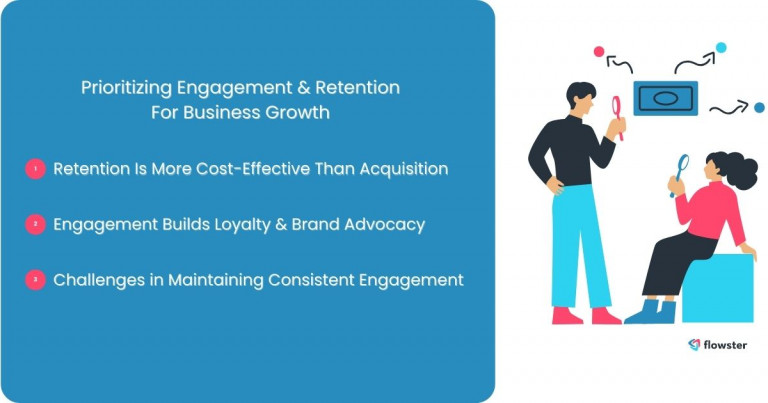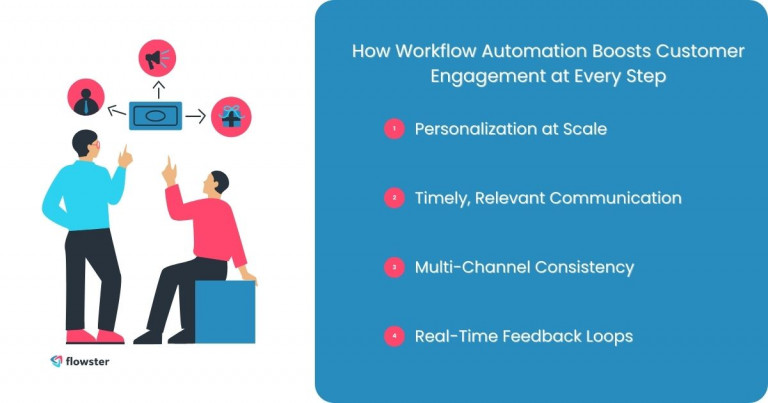Keeping customers engaged and coming back is harder than ever. With so many options out there, businesses have to work smarter to build real, lasting relationships.
That’s where workflow automation for customer engagement comes in. It helps you stay connected with your audience in a consistent, personalized way—without burning out your team.
In this article, we’ll walk through how automation can transform your customer interactions, boost retention, and give your business a competitive edge.
Article Outline
What Is Workflow Automation and How Does It Apply to Customer Engagement?
Before diving into the benefits, let’s clarify what workflow automation actually means and how it applies to customer-focused activities.
What is Workflow Automation? At its core, workflow automation uses software to complete tasks and processes with minimal human input. Think of it as a digital assistant that never forgets a follow-up or misses a deadline.
In the context of workflow automation for customer engagement, this means automating repetitive tasks like sending emails, updating CRM records, or assigning support tickets.
How It Applies to Customer-Facing Processes Workflow automation isn’t just about efficiency—it’s about experience. It allows businesses to respond quickly to customer needs, personalize interactions, and deliver a seamless journey from first contact to repeat purchase.
For example, a new lead can automatically receive a welcome email, get added to a nurturing sequence, and be flagged for follow-up if they show interest.
Common Tools and Platforms There are tons of tools out there to support automation. CRMs like HubSpot and Salesforce, email marketing platforms like Mailchimp, and customer support tools like Zendesk all offer automation features.
One powerful option is Flowster, which makes it easy to create and manage detailed workflows that keep your team aligned and your customers engaged.
By leveraging these tools, businesses can ensure that no customer falls through the cracks.
Wrap-Up Workflow automation simplifies complex processes and gives your team more time to focus on what really matters—building meaningful relationships with your customers.
Next, let’s take a closer look at why customer engagement and retention should be at the top of your business priorities.
Flowster's AI-Driven Automation
Why Prioritizing Engagement and Retention Is Key to Business Growth
Customer engagement and retention aren’t just buzzwords—they’re the backbone of long-term success. Let’s explore why.
Retention Is More Cost-Effective Than Acquisition It’s well known that keeping a customer is far cheaper than acquiring a new one. Some studies say it costs five times more to attract a new customer than to retain an existing one.
Focusing on retention helps businesses maximize the lifetime value of each customer and improve ROI on marketing spend.
Engagement Builds Loyalty and Brand Advocacy Customers who feel valued and heard are more likely to stick around. Timely, personalized interactions show customers that your brand understands them.
This is where workflow automation for customer engagement shines—it ensures every interaction feels intentional and thoughtful.
Challenges in Maintaining Consistent Engagement Manual engagement efforts can be inconsistent and unsustainable as your business grows. Teams may forget to follow up or send the right content at the right time.
Automation helps you overcome these gaps and maintain steady, quality communication across the entire customer journey.
Wrap-Up When you prioritize engagement and retention, you create a stable foundation for growth. In the next section, we’ll look at how automation makes it easier to engage customers in meaningful ways—at scale.
This Image list the reasons why prioritizing engagement and retention is key to business growth to encourage the readers use workflow automation for customer engagement.

How Workflow Automation Boosts Customer Engagement at Every Step
Now let’s break down how workflow automation for customer engagement delivers results throughout the entire customer journey.
Personalization at Scale It’s hard to send personalized messages to hundreds—or thousands—of customers manually. Automation makes this easy by using segmentation and behavior-based triggers.
You can automatically send tailored content based on user interests, purchase history, or where they are in the funnel.
Timely, Relevant Communication Automation ensures your message reaches the right person at the perfect time. Whether it’s a birthday greeting, a cart reminder, or a “we miss you” email, it can all happen automatically.
This real-time responsiveness keeps your brand top of mind and strengthens engagement.
Multi-Channel Consistency Customers expect a consistent experience whether they’re interacting with you via email, chat, or social media. Automated workflows can coordinate communication across channels.
Additionally, if your business relies on distributors, resellers, or strategic partners, partner relationship management software can help ensure consistent messaging and engagement across your extended network. PRM tools let you automate partner onboarding, track performance, and keep your entire ecosystem aligned with your customer engagement strategy.
This makes it easier to stay organized and ensures messaging feels seamless, no matter where the customer connects.
Real-Time Feedback Loops Collecting feedback doesn’t have to be manual. You can automate surveys and review requests after key touchpoints, like after a purchase or support interaction.
It shows customers their voice matters and gives you valuable insights to improve.
Wrap-Up Workflow automation gives you the tools to engage customers in ways that are personal, timely, and scalable. In the next section, we’ll dive into how automation supports long-term retention.

How Automation Strengthens Customer Retention
Great engagement brings people in, but smart automation helps keep them around. Let’s explore how workflow automation supports retention.
Customer Onboarding That Makes a Strong First Impression The journey begins right after a customer signs up or makes a purchase. An automated customer onboarding sequence can deliver welcome messages, helpful resources, and set clear expectations.
This builds trust and reduces the chance of early drop-off.
Loyalty and Rewards Programs on Autopilot Rewarding repeat business is key to retention. Automation lets you track purchases and trigger rewards without lifting a finger.
You can automatically enroll customers in loyalty programs or send exclusive offers based on buying behavior.
Re-Engagement Campaigns for Dormant Customers Not every customer stays active. But that doesn’t mean they’re lost.
Automated win-back emails or check-in messages can bring them back by showing you still care and offering something of value.
Post-Purchase Support and Education Support doesn’t stop after the sale. Use automated customer support to answer FAQs, deliver tutorials, and offer troubleshooting tips.
Keeping customers informed post-purchase increases satisfaction and reduces churn.
Wrap-Up Retention doesn’t happen by accident. Workflow automation makes it easy to stay in touch, add value, and keep customers coming back. Next up: best practices to help you get started.

Tips for Getting Started with Workflow Automation
Ready to dive into workflow automation for customer engagement but not sure where to begin? Start small and scale smart.
Automate One Workflow at a Time Trying to do everything at once can be overwhelming. Pick one customer journey—like onboarding or follow-ups—and automate that first.
Once it’s running smoothly, move on to the next area.
Map Out the Customer Journey Before building any workflows, take time to understand how your customers interact with your brand. Identify key touchpoints where automation can add value.
This keeps your automations relevant and helpful.
Use Data to Personalize Automation Data is your best friend. Use it to segment your audience and trigger automations based on behavior, preferences, or history.
The more relevant your messages, the stronger the engagement.
Test, Measure, and Improve Set it and forget it? Not quite. Review your workflows regularly to see what’s working and what’s not.
Tweak messages, timing, or logic to improve results over time.
Wrap-Up Workflow automation isn’t just a tool—it’s a strategy. And with the right approach, it can revolutionize the way you connect with your customers.
Capture Your Processes in Minutes!
Conclusion: Start Enhancing Customer Engagement with Workflow Automation Today
We’ve covered how workflow automation for customer engagement can improve every part of the customer journey—from that first welcome email to long-term loyalty and support.
The beauty of automation is that it creates space. Space for your team to focus on meaningful conversations, personalized service, and smart growth.
If you’re ready to make customer engagement easier and more effective, give Flowster a try. It’s a great solution—especially if you’re managing workflows remotely. See how Flowster for remote teams can streamline your operations and take your customer relationships to the next level.




